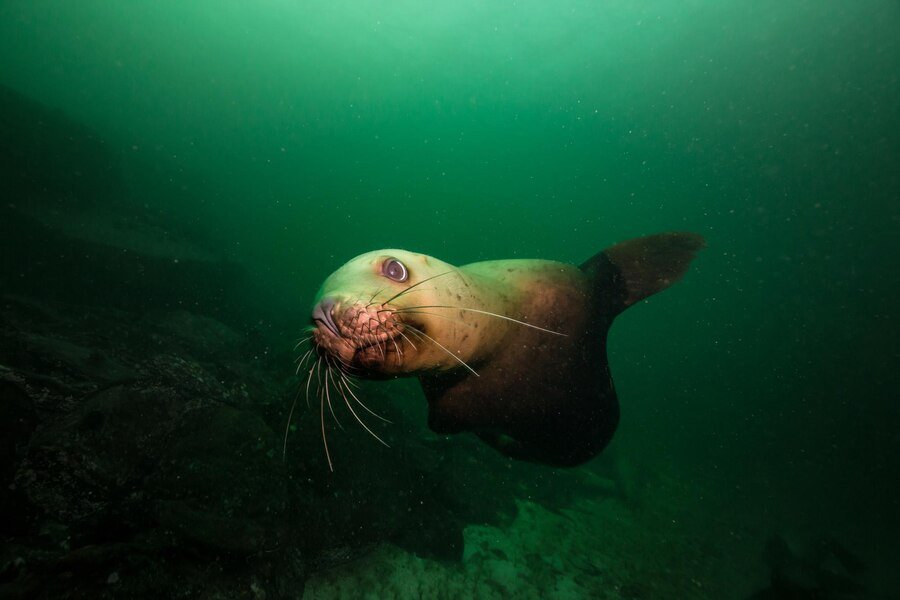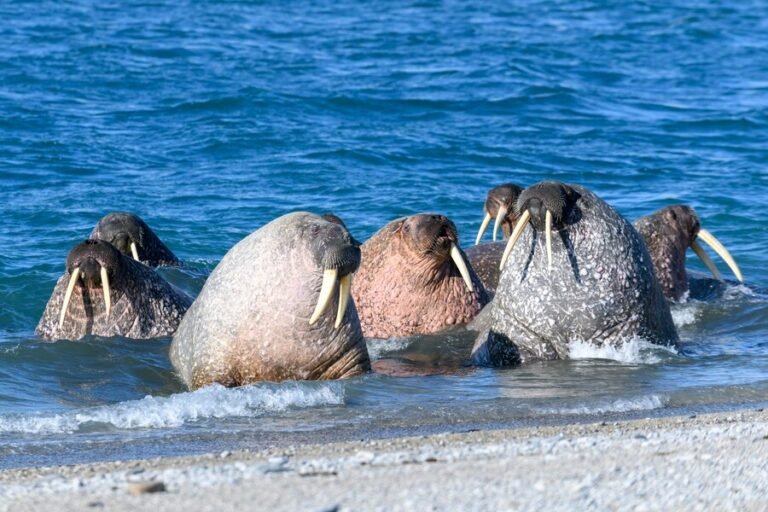Every marine biologist knows that the ocean is a treasure trove of fascinating creatures, each one deserving of study. Among these, the walrus stands out as an enigmatic and captivating species. Known for their distinctive tusks and whiskered faces, walruses are not only a symbol of the Arctic but also a key subject of marine research. This blog aims to explore the wondrous world of walruses, offering insights into their habitat, behavior, and the importance of their conservation. By the end, you’ll have a deeper appreciation for these magnificent mammals and the vital role they play in our oceans.
Introduction to Walruses: A Brief Overview
Walruses are large marine mammals found in the Arctic regions of the Northern Hemisphere. Characterized by their long tusks, thick blubber, and distinctive whiskers, they are members of the pinniped family, which also includes seals and sea lions. Their unique physical traits not only make them easily recognizable but also serve essential functions in their survival.
Throughout history, walruses have captured the imagination of humans, depicted in art and literature as mystical creatures of the sea. Science, however, offers a more grounded perspective. Marine biologists have been studying these animals for decades, uncovering fascinating details about their lives beneath the icy waters.
Understanding walruses is not just about satisfying curiosity. It provides critical insights into the health of Arctic ecosystems and highlights the broader implications of climate change. By studying walruses, scientists can gain valuable information about the dynamics of predator-prey relationships, the impacts of sea ice loss, and the interdependence of marine species.
Habitat and Distribution: Where in the World to Find Walruses
Walruses primarily inhabit the Arctic and sub-Arctic regions. They can be found in the shallow waters of the Atlantic and Pacific Oceans, where they haul out on ice floes or coastal beaches. Their distribution is closely linked to the presence of sea ice, which serves as a crucial platform for resting, molting, and birthing calves.
There are two distinct subspecies of walruses, each adapted to its specific region. The Atlantic walrus (Odobenus rosmarus rosmarus) is found in the northeastern parts of Canada, Greenland, and the waters surrounding Svalbard. Meanwhile, the Pacific walrus (Odobenus rosmarus divergens) roams the Bering, Chukchi, and Laptev Seas. The concentration of these populations highlights the ecological significance of these regions as pivotal walrus habitats.
Despite their adaptability to cold environments, walruses face significant challenges due to climate change. The rapid melting of Arctic ice threatens their traditional habitats, leading to shifts in their distribution patterns. Understanding these changes is crucial for marine biologists working to predict and mitigate the impacts of global warming on walrus populations.
Physical Characteristics: The Anatomy of a Walrus
The walrus is an extraordinary example of adaptation to a harsh environment. With their robust bodies covered in thick blubber, they are well-insulated against the frigid Arctic temperatures. This blubber not only provides warmth but also serves as an energy reserve during times of food scarcity.
One of the most iconic features of the walrus is its tusks. These elongated canines can grow up to three feet in length and are present in both males and females. Tusks serve multiple purposes, from aiding in hauling out on ice to establishing dominance within social groups. They are also used as tools for foraging and defense against predators.
In addition to tusks, walruses possess highly sensitive vibrissae, or whiskers, which help them detect prey in murky waters. These tactile hairs are a critical sensory organ, allowing walruses to feel their way across the ocean floor and locate clams, their primary food source. Understanding the functional anatomy of walruses provides deeper insights into their ecological roles and adaptive strategies.
Feeding and Diet: What Do Walruses Eat?
Walruses are benthic feeders, meaning they primarily forage for food on the ocean floor. Their diet mainly consists of bivalve mollusks, such as clams and mussels. A single walrus can consume thousands of clams in one meal, using their powerful suction to extract the soft insides from the shells.
Foraging typically occurs in shallow waters, where walruses use their sensitive whiskers to locate prey buried in the sediment. They can travel significant distances in search of food, relying on their strong swimming capabilities to cover large areas of ocean.
The feeding habits of walruses play a vital role in the Arctic marine ecosystem. By disturbing the sediment during foraging, they contribute to nutrient cycling and create opportunities for other species to access buried food sources. Their role as a keystone species highlights the interconnectedness of marine life and underscores the importance of preserving their habitats.

Social Behavior: How Walruses Interact with Each Other
Walruses are highly social animals, often found in large herds that can number in the hundreds or even thousands. These gatherings are essential for their survival, providing safety in numbers and opportunities for social interaction. Within these groups, walruses exhibit a range of behaviors, from play and communication to competitive displays.
Communication among walruses is complex, involving a variety of vocalizations and physical gestures. These vocalizations include bell-like sounds and grunts, which can be used to establish territory or attract mates. Physical interactions, such as tusk sparring and body contact, also play a role in maintaining social bonds and hierarchy.
Social structure is particularly important during the breeding season, when males compete for access to females. Dominance is often established through displays of size and strength, with larger males typically having greater success in securing mates. Understanding the social dynamics of walrus herds provides valuable insights into their reproductive strategies and overall behavior.
Reproduction and Life Cycle: The Family Life of Walruses
Walruses have a relatively slow reproductive cycle, with females giving birth to a single calf every two to three years. Mating usually occurs in the water, with males seeking out females by following their vocalizations. Once a pair forms, they engage in a series of courtship behaviors, including synchronized swimming and vocal exchanges.
Gestation lasts for about 15 to 16 months, after which the female gives birth to a calf, typically on a sea ice floe. Calves are born with a thick layer of blubber and are able to swim shortly after birth. Mothers are highly attentive, nursing their young for up to two years and teaching them essential survival skills.
The extended parental care provided by female walruses emphasizes the importance of stable environments for calf development. Disruptions to their habitats, such as the loss of sea ice, can have significant impacts on reproductive success and population stability. Conservation efforts must prioritize the protection of breeding grounds to ensure the continued survival of walrus populations.
Conservation Status: The Current State of Walrus Populations
Walruses are currently classified as “vulnerable” by the International Union for Conservation of Nature (IUCN). This designation reflects the multiple threats they face, including climate change, habitat loss, and human disturbances. The melting of Arctic ice due to rising global temperatures is perhaps the most pressing concern, as it directly impacts their ability to find food, rest, and reproduce.
In addition to climate change, walruses face threats from commercial activities such as shipping, oil exploration, and fishing. These activities can lead to habitat degradation, pollution, and increased human-wildlife conflicts. The cumulative effects of these threats underscore the need for comprehensive conservation strategies that address both environmental and anthropogenic factors.
Efforts to protect walrus populations require collaboration among governments, researchers, and local communities. By implementing policies that limit greenhouse gas emissions and regulate industrial activities in the Arctic, we can work towards preserving the natural habitats that walruses depend on for survival.
The Importance of Studying Walruses: Insights for Marine Biology
Studying walruses offers valuable insights into the intricacies of Arctic ecosystems and the broader impacts of climate change. These animals serve as important indicators of environmental health, providing clues about the state of their habitats and the challenges they face.
Research on walruses contributes to our understanding of marine mammal physiology, behavior, and ecology. By examining their adaptations to cold environments, scientists can gain insights into the evolutionary processes that shape life in extreme conditions. Additionally, studying walrus populations helps inform conservation efforts and guide policy decisions aimed at protecting vulnerable species.
For marine biologists, walruses represent a unique opportunity to explore the complexities of life in the Arctic. By continuing to study these fascinating creatures, we can deepen our understanding of the natural world and work towards ensuring a sustainable future for all marine life.
Conclusion
In conclusion, walruses are remarkable animals that play a crucial role in Arctic ecosystems. Their unique adaptations, social behaviors, and ecological significance make them a valuable subject of study for marine biologists. However, their survival is under threat from climate change and human activities, highlighting the urgent need for conservation efforts.
